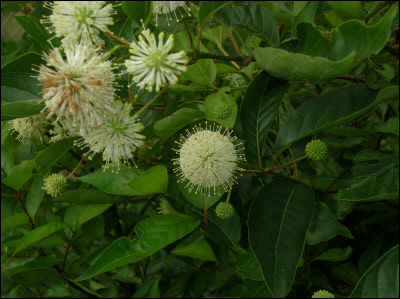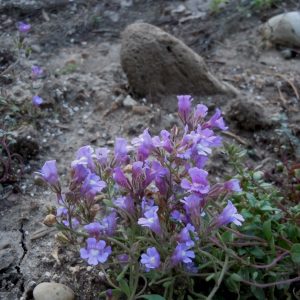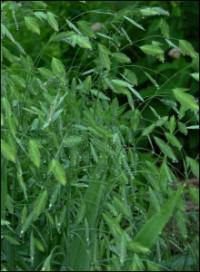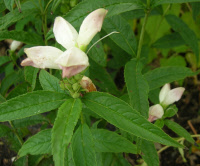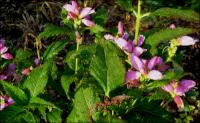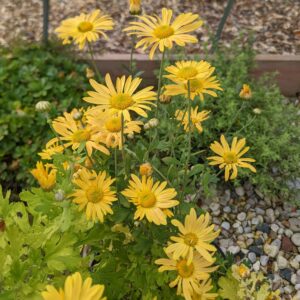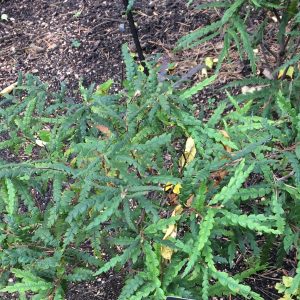Plants for Butterflies and Other Pollinators
Showing 49–56 of 211 results
-
Cephalanthus occidentalis Button bush, Honey balls Z 4-10
Perfectly round, white flowers perfume the air in Aug. & Sept. Red leaf stems contrast with green foliage.
Perfectly round, white flowers perfume the air in Aug. & Sept. Red leaf stems contrast with green foliage. Ships only in spring
Size: 6' x 8'
Care: Full sun to part shade in wet to moist well-drained soil
Native: New Brunswick S. to Fla. W. to CA.
Wildlife Value: Important shrub to maintain water quality and for wildlife habitat. Its roots absorb nutrients in water and reduce erosion along water's edges. Flowers attract butterflies. Birds nest in branches.Many medicinal uses for several tribes – Chickasaw, Choctaw, Kiowa, Meskwaki and Seminole, believed to remedy sore eyes, toothaches, dysentery, hemorrhages, headaches, nausea, fevers, constipation, ailments in horses and “wolf ghost sickness.” Rand 1866: “Valuable for blooming at a season when the shrubbery is bare of flowers.” Offered for sale in Bartram Garden’s 1783 Broadside, America’s 1st plant catalog.
**LISTED AS OUT OF STOCK BECAUSE WE DO NOT SHIP THIS ITEM. IT IS AVAILABLE FOR PURCHASE AT OUR RETAIL LOCATION.
-
Chaenorhinum glareosum Dwarf snapdragon Z 5-9
Rare plant. Spires of tiny purple to blue trumpets with yellow throats spring, summer & fall. Love this itsy plant.
Rare plant. Spires of tiny purple to blue trumpets with yellow throats spring, summer & fall. Love this itsy plant.
Size: 4” x 9-12” semi-trailing cushion
Care: sun to part-shade in well-drained soil
Native: Spain
Wildlife Value: Attracts bees, butterflies and birds.1st described in 1838. Chaenorhinum means “honey lotus” in Greek.
-
Chasmanthium latifolium Northern Sea oats Z 5-9
Graceful, pendulous oat-like spikes
In August – December Northern sea oats bear pendulous panicles of oat-like spikelets, emerging green and turning bronze. They hang on all winter.
Size: 36" x 24"
Care: full sun to part shade in any soil
Native: Eastern U.S., New Jersey to Texas
Wildlife Value: attracts butterfliesIntroduced by Michaux (1746-1802) extraordinary French plant hunter, who searched much of eastern No. America for plants. Indians ate the seeds for food. Used ornamentally since Victorian times for fresh and dried arrangements.
-
Chelone glabra White turtlehead Z 3-8
Spikes of pink over-tones on white, two-lipped, turtlehead shaped blooms in fall
Spikes of pink over-tones on white, two-lipped, turtlehead shaped blooms in fall
Size: 24-36” x 12”
Care: sun to part shade in moist to moist well-drained soil, tolerates clay.
Native: eastern North America incl Wisconsin
Wildlife Value: Pollen for bumblebees. Breeding site for Baltimore Checkerspot butterflies. Deer resistant.The name Chelone originated with French colonial settlers in Nova Scotia before 1700. They called this “La Tortue,” meaning “turtle” in French. The word chelone is Greek for tortoise. A tea brewed from the leaves was said to increase the appetite.
-
Chelone obliqua Rose turtlehead Z 5-9
Rich pink turtlehead shaped blooms in fall
OUT OF STOCK
Rich pink turtlehead shaped blooms in fall
Size: 16-24" x 12"
Care: Part shade moist to moist well-drained soil, tolerates clay
Native: Central and southeastern America
Wildlife Value: Attracts Baltimore Checkerspot butterflies.The name Chelone originated with French colonial settlers in Nova Scotia before 1700. They called this plant’s white-flowered relative (Chelone glabra) “La Tortue,” meaning “turtle” in French. This pink one found in 1752 by Virginia plantsman John Clayton and sent to John Bartram in Philadelphia in 1765. Called the “red Chelone.” A tea brewed from the leaves was said to increase appetite.
-
Chrysanthemum x rubellum ‘Mary Stoker’ Z 4-9
Sprays of large, single warming yellow daisies, blushed with apricot top a bushy mound of light green leaves, Blooms late-summer to late-fall
OUT OF STOCK
Sprays of large, single warming yellow daisies, blushed with apricot top a bushy mound of light green leaves, blooms late-summer to late-fall
Size: 1-2’ x 2-3’ and spreading
Care: Full sun to part shade, tolerates normal, sandy or clay soil
Wildlife Value: Attracts bees, butterflies and birds. Deer resistant.One of the rubellum hybrids, Hybridized in the 1930’s
-
Cleome serrulata Rocky Mountain Beeweed, Spiderflower, Stinkweed Reseeding annual
Blooming all summer dozens of rose to lilac-colored flowers bunch together at the top of the 3-4” tall stem seemingly one soft-ball sized flower. Thread-thin stamens protrude above the flowers, each flower bearing six stamens, 72, for example, if the cluster contains a mere dozen individual flowers earning it the nickname spider flower. Short leaves grow the length of plant stems, from bottom to top, bare of flowers. A trio of leaflets to each leaf, one as a leader with two sidekicks.
OUT OF STOCK – EMAIL FOR AVAILABILITY
Blooming all summer dozens of rose to lilac-colored flowers bunch together at the top of the 3-4” tall stem seemingly one soft-ball sized flower. Thread-thin stamens protrude above the flowers, each flower bearing six stamens, 72, for example, if the cluster contains a mere dozen individual flowers earning it the nickname spider flower. Short leaves grow the length of plant stems, from bottom to top, bare of flowers. A trio of leaflets to each leaf, one as a leader with two sidekicks.
Size: 4' x 9"
Care: sun in moist-well drained to dry soil, drought tolerant
Native: Minnesota west to the Pacific, south to Arizona and New Mexico and all in between.
Wildlife Value: So many flowers, each with nectar and a hoard of stamens each holding pollen in a soft-ball sized object makes this a mecca for pollinators of all sorts, numerous bee species, wasps and several butterflies. When it’s done flowering birds eat its seeds. Its skunk-like odor (Stinkweed) has one advantage – it keeps the deer away.An ancient, pre-historic plant, Natives including Lakota, Zuni, Tewa, Navajo, and Pueblo found many uses for this Cleome. Some ate shoots, leaves, seeds or flowers, cooked them, or ate them raw alone or together with other food. Tewa grew this with corn, beans and squash to attract pollinators to pollinate the food plants. Infusions treated fever, and stomach aches. A poultice treated sore eyes. Lakota used this and a shrub to trap bison. Navajo color rugs with a yellow-green dye they make from Cleome. Pueblo Indians concentrate Cleome to make a thick, black paste to decorate baskets and pottery. Meriwether Lewis collected three of these two on the way west and one homebound traveling east.
-
Comptonia peregrina Sweet Fern Z 2-6 SHRUB
Grown for it’s fern like leaves, this small shrub flowers in spring with insignificant yellow flowers followed by brown nutlets. Foliage is fragrant when crushed.
Grown for its fern like leaves, this small shrub flowers in spring with insignificant yellow flowers followed by brown nutlets. Foliage is fragrant when crushed.
LIMITED QUANTITES AVAILABLE. ONE PER CUSTOMER PLEASE.
Size: 2-5’ x 4’ spreading
Care: sun to part shade in moist, well-drained to well-drained soil. Prefers acidic, but will grow in other types of soil as well. Drought and salt tolerant.
Native: Eastern North America, Wisconsin native
Wildlife Value: Attracts bees, butterflies, & birds. Larval host plant for many moths, including Io moth, several Sphinx moth species, and the Anise Swallowtail butterfly. Deer resistant. Nitrogen fixer.Genus name honors Henry Compton (1632-1713), Bishop of London and patron of botany. Peregrina means exotic or immigrant. Many Native Americans (Algonquin, Cherokee, Chippewa, Delaware, Menominee, Delaware, Potawatomi) used this plant for a wide variety of purposes: Crushed leaves inhaled for headache. Leaf infusions for: round worms, fevers, beverage, blood purifier, blisters, clear mucus from lungs, bladder inflammation, rash from poison ivy, swelling, flux, stomach cramps, itch. Fragrant leaves- burned or crushed for incense in ceremony, perfume, Decoction – childbirth, tonic, Other: sprinkle on medicine to poison enemy, prevent blueberries from spoiling, leaves in fire to make smudge to ward off mosquitoes. Oneida made a tea.
Collected for botany before 1753. Grown at America’s 1st botanic garden, Elgin Botanic Garden 1811.**LISTED AS OUT OF STOCK BECAUSE WE DO NOT SHIP THIS ITEM. IT IS AVAILABLE FOR PURCHASE AT OUR RETAIL LOCATION.

